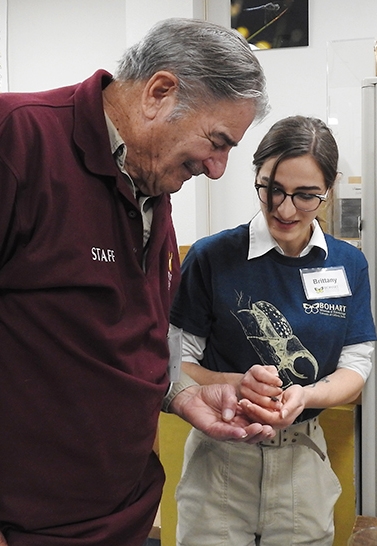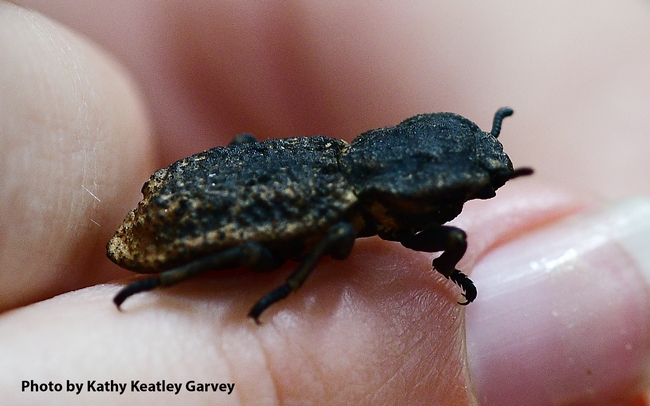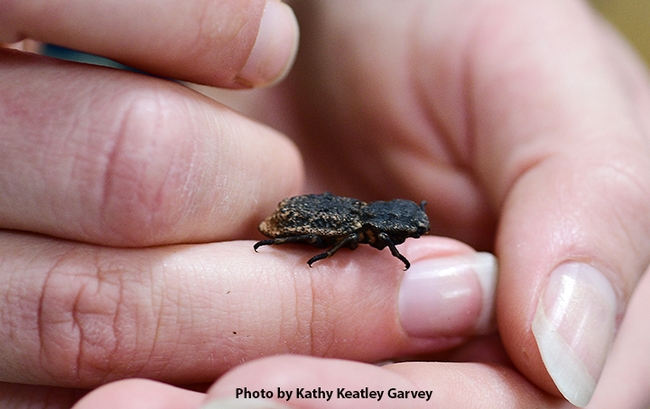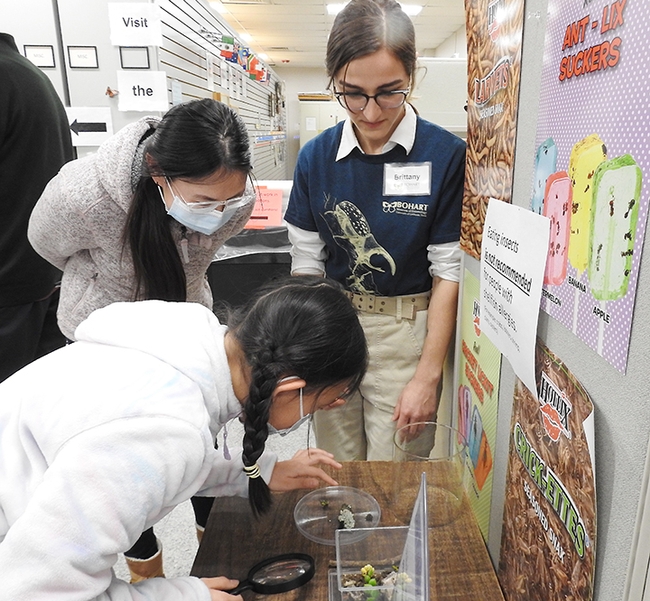
Curious visitors crowded around the flightless beetle, taking multiple cell phone images as Kohler fielded multiple questions.
"I found it in the Sierra Foothills, by Murphys," said Kohler, a UC Davis alumna and prospective graduate student. Murphys, located in Calaveras County, sits in the central Sierra Nevada foothills between Lake Tahoe and Yosemite National Park.
What's unusual about this inch-long beetle, found in the deserts of western North America and living on fungi growing under tree bark?
It lies flat and low to the ground and is built like a little armored tank. It can withstand crushing forces--not just your foot, a pinch, or a battering ram, but a 3400-pound car. UC Riverside researcher Jesus Rivera, now of UC Irvine, performed compression tests in 2015: a Toyota Camry drove over the beetle twice and it survived.
"A 200-pound man would have to endure the crushing weight of 7.8 million pounds to equal this feat," according to a UCI news release, published Oct. 21, 2020.
Rivera's research, "Toughening Mechanisms of the Elytra of the Diabolical Ironclad Beetle," published in the Oct. 21 edition of Nature, drew widespread coverage, ranging from the New York Times and Science to the Smithsonian magazine.
The beetle's tough structure, notably the densely layered and interlocking wing covers, or elytra, seem out of this world.
"...The beetle's exoskeleton uses internal layers, tight joints and overall near-indestructible shape to give it both toughness and flexibility under pressure," wrote correspondent Theresa Machemer in the Oct. 22 edition of the Smithsonian magazine.

Katherine Wu of the New York Times related that the researchers "assessed the tensile strength and composition of the beetle's exterior with a suite of ultrasensitive instruments. The ironclad's exoskeleton, they found, was packed with proteins that seemed to enhance its durability. It was also cleverly structured: Evolved from a pair of now-defunct forewings, the exoskeleton stretched across the insect's back and hooked into a separate structure sheathing the insect's belly, encasing the beetle in a shell with an airy buffer underneath."
Wu compared the arrangement "to an industrial-strength egg, with the yolk sloshing gently against a cushion of whites."
Said Kohler of the Bohart Museum display: "Surprisingly, none of the visitors really knew about them; they were interested to learn that they were so tough externally and that they ate mushrooms--they are fungiphores. The children had the best time using the magnifying glasses to look at them along with being able to touch, and hold them!"
The amazing world of insects...
The Bohart Museum of Entomology, located in Room 1124 of the Academic Surge Building, 455 Crocker Lane, houses a global collection of eight million insect specimens, including a million beetles. Directed by Lynn Kimsey, UC Davis distinguished professor of entomology, UC Davis Department of Entomology and Nematology, the museum also houses a live "petting zoo" (Madagascar hissing cockroaches, stick insects, tarantulas and more) and a year-around gift shop. The Bohart is open to the public from 8 a.m. to noon, and 1 to 5 p.m., Mondays through Thursdays.
Attached Images:

A diabolical ironclad beetle, Phloeodes diabolicus, held by Bohart Museum research associate Brittany Kohler. (Photo by Kathy Keatley Garvey)

Open house visitors examine the diabolical ironclad beetle, Phloeodes diabolicus. In back is Bohart research associate Brittany Kohler, who collected the beetles in the Sierra Foothills. (Photo by Kathy Keatley Garvey)